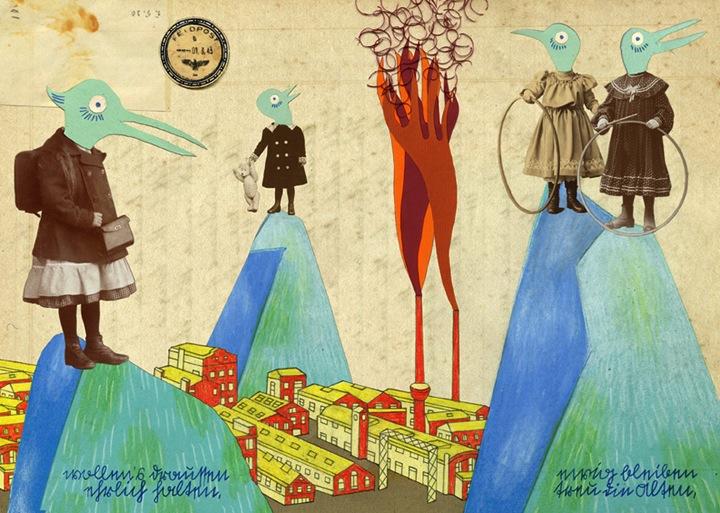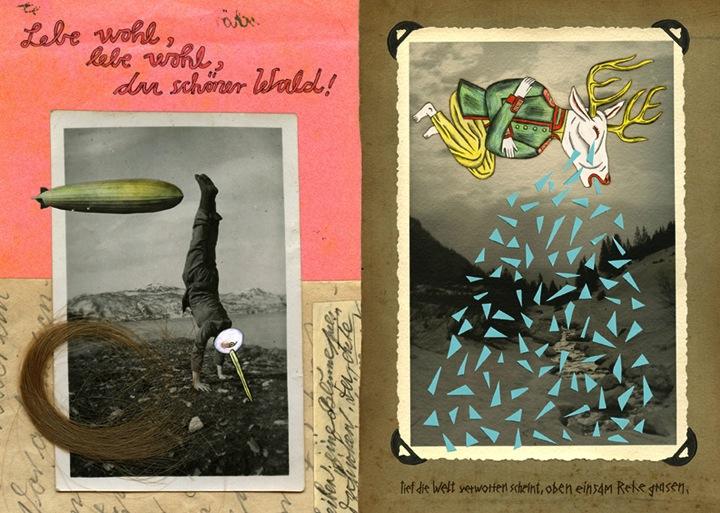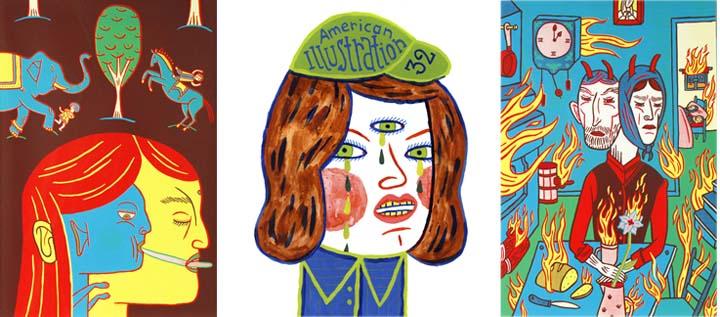The Q&A: Nora Krug
Q: Originally from Germany, what are some of your favorite things about living and working in New York City?
A: That I can walk down the street and not see anybody who looks like me, listens to the same music, or reads the same books as I do. Living here feels like a never-ending cycle of breathing in, and exhaling energy.
How and when did you first become interested in art and illustration?
My parents dragged me from one Piero della Francesca fresco to another on our annual family trips across the Italian countryside in our
non-air-conditioned Volvo when I was a child. That was my exhausting introduction to the arts. My favorite children's books were those by Tomi Ungerer and
Maurice Sendak (anti-authoritarian children's books were the standard in 1970s Germany, and Disney wasn't allowed in our house).
But I also liked looking at old German
illustrated books, such as Grimm's fairytales and the 19th-century classic, Struwwelpeter, depicting in exaggerated detail what happens to little boys and girls if they misbehave. I didn't
realize that those books were actually made by people who referred to themselves as 'illustrators' until much later.
What is your favorite part of the creative process?
To me, the creative process is a struggle, and often a torturous one. Making art is a constant decision making process. How can I create tension between words and images? How do I translate emotion into line? How can I evoke empathy without being sentimental? How can I surprise the reader when he or she turns the page? How can I reinvent my work and avoid getting stuck on doing what I've done so many times before? Why is what I do important? Who cares?
If there's something that deserves to be called a 'favorite part', I would say it is the collaborative process in working with editors and
publishers, who have been very inspiring, and the moment when a drawing or a book is done. When I see it published and know that it communicates to someone somewhere in the world: When it takes on a
life of its own, and I can stop worrying about it.
Above
and below: Spreads from Der Jaeger Abschied ('The Hunters' Farewell'), (Corraini Editore,
2013).
Do you keep a sketchbook? What is the balance between the art you create on paper versus In the computer?
No. I suffer from white-page-snow-blindness. Sketchbooks intimidate me. I'm not a doodler. I never draw just for the fun of it. My work always begins with a concept, and I can go for long stretches of time without drawing, during which I just take notes or write. My ideas are never born from a medium or process.
Whether I draw on paper or use the computer depends on the concept and timeframe of a given project. I have a background in classical music, theater design and documentary film, and when I began studying illustration, I saw it as just one of many media available to communicate ideas. The act of drawing to me is a research process as much as an artistic process. Art doesn't happen separately from everything else in the world. It always reflects something about the society we live in. Through drawing, I try to get insights into how the world works. Of course I tell my students that they absolutely have to keep a sketchbook. I hope they don't read this.
What is the most important item in your studio?
Philosophically speaking, myself. Practically speaking, my table and my 2B pencils. Intellectually speaking, the illustrated books surrounding the drawing table (the French and Japanese ones in particular).
What are you listening to?
Music by Gnarls Barkley, Ceila Cruz, Blur or Max Raabe when I conceptualize ideas. When I draw, I listen to plays and discussions on the BBC's iPlayer all day long. I like to share a pipe in front of the cracking fire with Sherlock at 221B Baker Street, or to join in with the out-of-tune singing of the contestants of the non-sensical quiz show called, "I'm Sorry I Haven't a Clue".
What are you reading?
There is a dusty pile of
fiction and non-fiction books, and a few graphic novels on my bedside table. As for non-fiction, I love, Don't Let's Go to the Dogs Tonight, Alexandra Fuller's non-fiction account of
growing up in Zimbabwe, and Nothing to Envy, Barbara Demnick's collection of stories told by North Korean refugees. As for fiction, I'm a big fan of Ian McEwan's uncomfortable and
suspenseful Enduring Love and the ingenious wordsmanship of David Mitchell's, The Thousand Autumns of Jacob de Zoet. The Adventures
of Tintin, the boy reporter, bring me straight back into my childhood after a stressful day at work. 
Who and what are some of your strongest influences?
I admire different artists' work for different reasons: Chris Ware (storytelling), Joe Sacco (bravery), Tomi Ungerer (intellectual freedom), Henrik Drescher (intuitiveness), Tadanori Yokoo (bluntness), Oliver Schrauwen (focus on the subconscious). In regards to my visual non-fiction work, I'm also inspired by documentary filmmakers like Werner Herzog, Hubert Sauper, John Burgan and Chuen Bin Choi. My husband Steven Guarnaccia is probably the biggest influence, because he is the one whose judgement I trust most.
Did your participating in the AI32 LIVE Cover Project have any spillover into your studio practice? Do you recommend marathon art projects for inspiration or redirection?
I recommend it, but I myself don't often engage in marathon art projects. I prefer working at home with my headphones on, and a cold cup of tea on my drawing table.
What was the last art exhibition you saw and what did you take away from it?
A show at the Berlinische Galerie in Berlin, called, Wien Berlin, which compared Austrian and German works from the Secession, Expressionism and New Objectivity.
Have you ever had a creative block with a deadline looming? What do you do to get crackin’?
When I do commercial work with deadlines, I almost never have a creative block. It's the personal work I'm struggling with most. Nothing other than getting back to that darn drawing desk helps overcome the block.
What is/would be your karaoke song?
If I sang karaoke, it would be "Going to a Town," by Rufus Wainright, written on the eve of his leaving Bush-era America for Berlin.
What is your hobby?
I like to prune roses and to build outdoor shelters for stray cats.
Where do you teach—and what do you like best about teaching?
I'm an Associate Professor in the Illustration Program at Parsons The New School for Design. What I like most about teaching is that
it gives me the chance to push the boundaries of what illustration means today. Over the past seven years at Parsons, I've developed a set of inter-disciplinary classes, including Visual Politics
(where illustration and political science students work on politically-driven art) and Visual Music (where illustration and design students collaborate on experimental music videos with composition
students from The New School for Jazz and Contemporary Music). The ideas that the students come up with in these classes, and theircapability of reinventing the field, is very inspiring.
Left and right: Pages from Shadow Atlas (StraneDizioni). Center: Unique cover for American Illustration 32.
Where did your idea for Shadow Atlas originate? What was the most difficult part about getting from idea to finished art?
Shadow Atlas is a 32-page, silkscreened, alphabetical encyclopedia of the ghosts and spirits that various peoples in the world believe in. It was published by StraneDizioni, an alternative art publisher based in Italy. I was interested in exploring what different societies believe in, the universal fears that are embodied in some of those mysterious creatures and where these beliefs come from. The most difficult part was working in the tabloid-size format, and preparing the drawings for the eventual silkscreen process. I found it difficult to imagine the illustrations in four colors, including halftones, while having to prepare them in black-and-white.
What advice would you give to a young illustrator who is just getting noticed?
There is no secret recipe for success. Do the kind of work you are passionate about, not the kind of work you think is expected of you. Believe in yourself, but always question what you do. Think of yourself as an author; someone might be able to copy your style, but nobody can tell a story the way you can. Work hard. Don't drink and draw.
Nora Krug is a writer and artist whose work has appeared in the New York Times, le Monde Diplomatique and the Guardian, among other publications, and has been included in anthologies by Houghton Mifflin Harcourt and Chronicle Books. Her books, Red Riding Hood Redux, and Shadow Atlas, are included in the Library of Congress. Krug’s animations were featured at the Sundance Film Festival, and her visual narratives were recognized with a silver cube from the Art Director’s Club, and with three gold medals from the Society of Illustrators. Her visual biographies were included in Houghton Mifflin’s Best American Comics, and Best American Non-Required Reading. She is the recipient of a Guggenheim, a Sendak, and a Fulbright Fellowship, a DAAD scholarship, and a Pollock-Krasner grant. Krug is an associate professor in the Illustration Program at Parsons The New School for Design in New York City. She received a B.A. (honours) in Performance Design from Paul McCartney’s Liverpool Institute for Performing Arts, an M.F.A. in Illustration and Documentary Film from the University of Arts Berlin, and an M.F.A. in Illustration as a Visual Essay from the School of Visual Arts in New York City.


